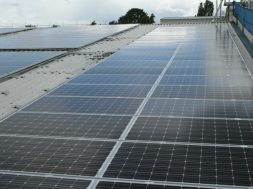
Mumbai: A sharp fall in solar module prices will help renewable energy producers, who have won solar projects at aggressive tariffs but are yet to procure equipment or start construction, leading to higher margins, according to company executives and analysts.
Costs of solar photovoltaic (PV) modules, a key component in setting up of solar plants, have been on a downward trend because of oversupply in China. Modules make up nearly 60% of a solar project’s cost.
Lower costs could mean several of the projects, which were termed unviable for being won at aggressive tariffs, could now see better investor sentiment, said Kartikeya Sharma, head of research and analytics at SunSure Energy, an EPC (engineering, procurement, construction) developer of solar projects.
A number of companies including Fortum Oyj’s Indian unit, Goldman Sachs-backed ReNew Power Ventures Pvt. Ltd, RattanIndia Solar, Adani Green Energy Ltd, Orange Renewable, and Mahindra Renewables have recently won solar project awards in various states.
Globally, module prices have already declined by as much as 10% since the first half of 2016, according to Bridge to India, a boutique consulting firm.
“Indian solar project developers will be relieved to see (module) prices coming down much more sharply than expected, providing an opportunity to improve returns despite aggressive bidding… The fall in prices comes at a perfect time for Indian solar market as Q1 2017 is expected to be the biggest quarter for new capacity addition till date,” Bridge to India said.
For a 10 megawatt (MW) scale plant, for example, prices of tier-1 modules have come down to 42 cents per watt in July 2016 from 55 cents per watt in January 2015—a drop of 23.6%, SunSure’s Sharma said. He expects module prices to fall another 10% in the months to come.
Solar modules are ranked as tier-1, tier-2, tier-3, and tier-4, where tier-1 are the highest quality modules from the top 2% of the manufacturers.
India is one of the few markets promising strong growth to global renewable energy firms and investors in such firms. It currently has about 8 gigawatt (GW) of installed solar capacity. Having added capacity at the fastest rate in 2016, India is expected to become the fourth largest solar market this year, overtaking the UK, Germany and France. The country has a target of setting up 100GW of solar and 60GW of wind energy capacity by 2022.
Companies that are in the process of putting up capacity to contribute to that pipeline will benefit from the falling module prices.
ReNew Power, for example, has a pipeline of 1,000 MW of yet-to-be constructed solar projects and only a part of them have already tied-up for equipment.
“If module prices come down by 1 cent or so then that would benefit projects which are yet to be constructed,” said founder and chief executive Sumant Sinha. ReNew has, however, kept its bids above Rs.5 in recent auctions.
Solar tariffs first fell below Rs.5 per unit in November, led by SunEdison Inc.’s aggressive bid of Rs.4.63 per kilowatt-hour (kWh) in a reverse online auction. Tariffs fell further to Rs.4.34 at a January e-auction conducted by state-run National Thermal Power Ltd (NTPC).
Recent bids in the range of Rs.4.6-5.3 per kWh imply a return on equity in a band of 6-13% depending on the cost of debt, JM Financial Institutional Securities Ltd had said in a report on 11 April. With equipment cost having fallen since, these developers could now expect a higher return, analysts suggest.
Solar projects won since January would benefit the most as construction typically commences between 8-12 months from the time of winning the project, said Divya Charen, analyst at India Ratings. There is a gap of 6-8 months from the time a project signs a power purchase agreement (PPA) with a buyer to the time it procures equipment and simultaneously looks for financial closure of project cost, said Sharma of SunSure.
Price reduction in India should be further aided by depreciation of the Chinese Yuan against the Indian Rupee by about 3-4% over last year, said Bridge to India adding the decline in effective costs has been significant to the tune of almost 10% in less than a year.











